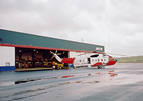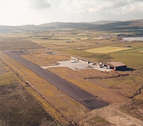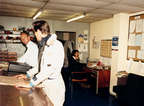...........Bristow Base: Shetland Islands, U.K.
Situated some 200 miles north of Aberdeen the Shetland
Islands have played a strategically important role in the
development of the northern North Sea oil fields. As
the
oil companies ventured ever further North in their search
for oil deposits so it soon became obvious that the helicopters
being used at the time would be stretched to their limits if
flying from the Scottish mainland.
 As
can be seen from this map of the northern North Sea
As
can be seen from this map of the northern North Sea
oil fields the Magnus field is approximately 300 miles from
Aberdeen airport and aircraft such as the S61 and Puma
would not have been able to fly this leg in one go.
It soon became clear that it would be to great advantage
to set up a base on the Shetland Islands and Sumburgh
was chosen as it was already handling oil support helicopters
operated by British Airways Helicopters.
 The
first Bristow aircraft to operate from Sumburgh was
The
first Bristow aircraft to operate from Sumburgh was
probably a Wessex in 1972 but in 1973 a number of S61s
joined the base and as can be seen from the photo Pumas
and Bell 212s ( this one in Okanagan colours) were also
used.
 Busy day at Sumburgh circa 1978/79.
Busy day at Sumburgh circa 1978/79.
 The
Bristow hanger is the one with the blue roof and the
The
Bristow hanger is the one with the blue roof and the
terminal is on the left of the picture. As the operation
rapidly expanded, hangars and accommodation had to be
provided to keep up and at The Sumburgh Hotel an
extension block was added at the rear of the hotel which perfectly blended in
with the existing architecture. I think not!
Houses were also built in an effort to persuade personnel to take on the Shetland
climate which can be bleak and majestic at the same time with long daylight
hours
in the Summer and seemingly longer hours of darkness during Winter months.
 Taken
around 1975 it is interesting to compare this picture
Taken
around 1975 it is interesting to compare this picture
with the one above to appreciate the level of development
that was required to keep up with the North Sea oil boom.
 The
airport terminal has provided facilities second to none
The
airport terminal has provided facilities second to none
but from its conception the helicopter operators and oil
companies had felt they were being forced to take on an
expensive option and Bristows would have probably
preferred to operate its own facilities.
 Sumburgh
has lost all its commercial helicopter operations
Sumburgh
has lost all its commercial helicopter operations
with various reasons being given. The arrival of longer
range aircraft such as the Chinook and Super Puma meant
that most of the rig flights could be operated directly from
Aberdeen but when Shell finally pulled out and joined a
consortium operating out of SCATSTA one of the reasons given was the number
of bad weather days averaging 26 compared to SCATSTA's 4.
The above picture is of S61 G-BCLC which is operated on behalf of HM Coast-
guard, this being the standby machine with G-BDOC in the hangar whilst I was
surveying it prior to it undergoing an avionic update at Redhill in 2001. These
are the only Bristow aircraft based at Sumburgh at the present time.
 The
move away from Sumburgh started around 1979 with
The
move away from Sumburgh started around 1979 with
Chevron operating flights out of Unst initially using it as a
staging post as no hangars were available. As the hangar
and other facilities came on line so aircraft were based
there on a permanent basis.
 A couple of S61s in the Unst hangar.
A couple of S61s in the Unst hangar.
I think it can safely be assumed that Unst was the UK's
most northern airfield and it must have felt a long way
from civilisation in the early days.
 Unst
Flight Operations where flights to the numerous
Unst
Flight Operations where flights to the numerous
offshore installations were planned. The notice board
contained details of rig positions and movements because
many of the offshore helipads were constantly on the
move.
 Another
advantage of short helicopter flights is the cost
Another
advantage of short helicopter flights is the cost
saving as a cheaper seat-mile aircraft can be used to fly
the majority of the journey. This Brymon Airways Dash 8
was probably on the Aberdeen - Unst run.
 A
muddy G-BFRI at Unst. "It was on the helideck of
A
muddy G-BFRI at Unst. "It was on the helideck of
one of the Ninian platforms when the "mud"
pipe to the
wellhead burst. The cabin attendant was outside the
aircraft when the pipe went and he arrived back at Unst
looking like the original flower grader!"
When construction of the Sullom Voe oil terminal was commenced a small airfield
was constructed to transport construction workers to and from the UK mainland.
In the mid nineties oil companies looked to SCATSTA as a possible location to
consolidate Shetland Islands oil support operations. They moved from Unst and
Shell joined them from Sumburgh in 1999 after a 30 year association with the
airport. Prior to Shell moving to SCATSTA the airfield was given a $3.5 million
facelift including runway reinforcement, navaid upgrade and expansion of the
terminal facilities. As of mid 2000 the SCATSTA consortium was operating around
5 Super Pumas ( Tigers).